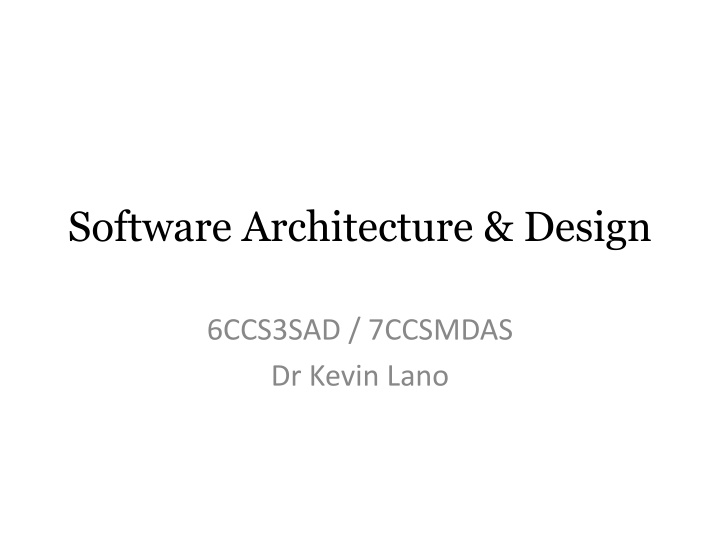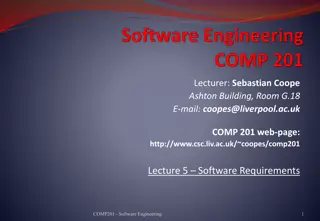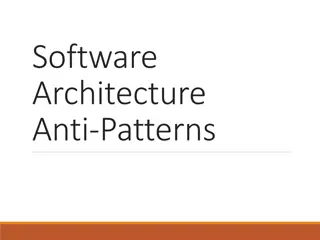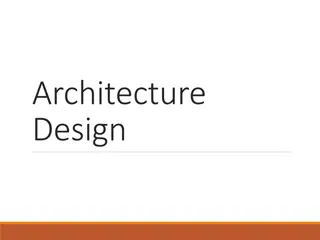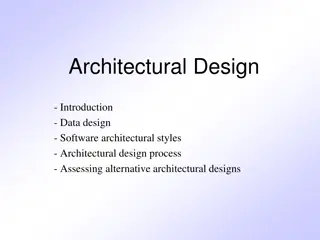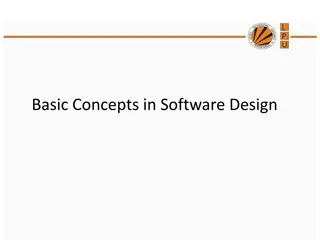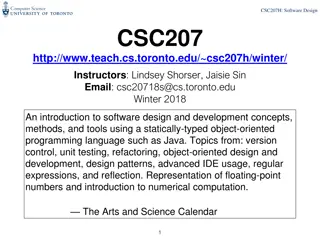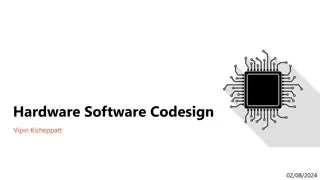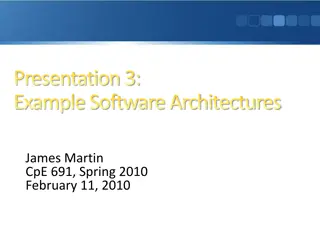Software Architecture & Design
This content discusses Model-Driven Engineering (MDE) and how it can address issues in software development by automating processes, enforcing architectural constraints, and improving consistency. MDE involves transforming models into code and text, simplifying reuse, and increasing efficiency.
Download Presentation

Please find below an Image/Link to download the presentation.
The content on the website is provided AS IS for your information and personal use only. It may not be sold, licensed, or shared on other websites without obtaining consent from the author.If you encounter any issues during the download, it is possible that the publisher has removed the file from their server.
You are allowed to download the files provided on this website for personal or commercial use, subject to the condition that they are used lawfully. All files are the property of their respective owners.
The content on the website is provided AS IS for your information and personal use only. It may not be sold, licensed, or shared on other websites without obtaining consent from the author.
E N D
Presentation Transcript
Software Architecture & Design 6CCS3SAD / 7CCSMDAS Dr Kevin Lano
Session 9: Model-Driven Engineering I March 11th, 2019
Learning Outcomes At the end of this session you should be able to: Explain the benefits of automation in software development; Explain the MOF meta-modelling architecture 3
So far Architecture models constructed manually Abstract Architectures Concrete Architectures for .NET Architectural Styles Architectures are then passed on to developers for manual design and implementation 4
Problems Enforcing architectures and constraints? Errors introduced through manual implementation Reuse? 5
Today Model-Driven Engineering (MDE) can help address these problems Automatically transform models all the way to code Enforce architectural constraints Avoid implementation errors Simplify reuse and increase consistency
Model-Driven Engineering (MDE) Overview Models as central artefacts of software development Architecture, design, ... Model transformations to encode and automate processing of models Model-to-model (M2M): Transform models into other models Model-to-text (M2T): Transform models to source code or other text
Model-Driven Engineering (MDE) Model-to-text: Transform models to source code/text
Model-to-Text Transformations Programs that Take a model (or models) as input For example, an architecture diagram Requires formalised (i.e., computer processible) representation of the model Produce a text file (or files) as output Often, but not always, source code
Model-to-Text Transformations Requires formalised (i.e., computer processible) representation of the model
Models Models are abstractions of a system Different from the system details are left out Can be used as an example to produce a system Models are descriptions of a system written in a well- defined modelling language Modelling languages we have used: To design class hierarchy of a system using language of UML class diagrams To design system architecture using UML2 component- diagram language To design a COM+ specific system architecture using COM+ specialization of UML2 component diagrams
Metamodels A metamodel is a description of a modelling language A model of models Defines all concepts that can be used within a language A model is constructed using the syntax defined by a metamodel You know a range of metamodels: UML class diagrams UML2 component diagrams .NET/COM+ specialization Relational data model diagrams XMLSchema for XML documents
Models, languages and metalanguages Meta- Language is written in <<EJBDataSchema>> RoomRes Metamodel <<EJBDataClass>> Breakfast <<EJBDataClass>> CustomerDetails <<EJBDataClass>> RoomRes <<EJBDataSchema>> RoomRes Juice:string Meal:string RoomNumber:int CustomerID:int <<EJBDataClass>> Breakfast <<EJBDataClass>> CustomerDetails <<EJBDataClass>> RoomRes RoomNumber:int Juice:string Meal:string CustomerID:int is written in <<EJBDataSchema>> RoomRes Model <<EJBDataClass>> Breakfast <<EJBDataClass>> CustomerDetails <<EJBDataClass>> RoomRes RoomNumber:int Juice:string Meal:string CustomerID:int
The Meta-Object Facility (MOF) Is an OMG standard for defining modelling languages OMG = Object Management Group A model of meta-models (a meta-metamodel) UML, the OCL, relational database models, specializations of UML can all be represented in the MOF An object-oriented approach to defining modelling languages Modelling concepts defined as meta-classes Meta-classes themselves are instances of MOF classes 4 layered architecture to define the modelling / meta- modelling process Layers M0 to M3
Layers M0 and M1 We already know these Layer M0 is the actual running system E.g., component instances E.g., customer objects, representing actual customers accessing an ecommerce system Layer M1 is a system model Defines the types of entities and relationships that make up a system E.g., component specifications E.g., a UML class model, defining a Customer class that specifies that customer objects are system entities Every element of M0 is an instance of an element from M1
Layers M0 and M1 M0: System (at runtime) :Customer title = Dr name = Jekyll :Customer title = Mr name = Hyde
Layers M0 and M1 Customer title : String name : String M1: Model of a System M0: System :Customer title = Dr name = Jekyll :Customer title = Mr name = Hyde
Layers M0 and M1 Customer title : String name : String <<instance-of>> <<instance-of>> M1: Model of a System M0: System :Customer title = Dr name = Jekyll :Customer title = Mr name = Hyde
Layers M0 and M1 :Customer title = Dr name = Jekyll :Customer title = Mr name = Hyde Notation: : and underscore to indicate objects This is an object diagram
Layers M0 and M1 Notation: No : nor underscore to indicate class This is a class diagram Customer title : String name : String
Layer M2 For a modelling tool, all elements of a model are objects They are on M0 Their classes are things like Class , Attribute , or Association A meta-model (M2 model) reflects this: Meta-classes on M2 are instantiated by model elements on M1
M0 as instance of M1 Customer title : String name : String <<instance-of>> <<instance-of>> M1: Model of a System M0: System :Customer title = Dr name = Jekyll :Customer title = Mr name = Hyde
Layer M2 M1: Model of a System Customer title : String name : String
Layer M2 M1: Model of a System :UML Attribute name = title type = String :UML Class name = Customer :UML Attribute name = name type = String
Layer M2 M2: Meta-model of UML M1: Model of a System :UML Attribute name = title type = String :UML Class name = Customer :UML Attribute name = name type = String
M1 as instance of M2 Instantiation of associations by links. This happens between M1 and M0, too. UML Attribute name : String type : String 1 UML Class name : String * <<instance-of>> <<instance-of>> M2: Meta-model of UML M1: Model of a System :UML Attribute name = title type = String :UML Class name = Customer :UML Attribute name = name type = String Notation: : and underscore to indicate objects 17/03/2016 This is an object diagram Side note: The actual UML meta-model is more complex and uses different names for the meta-classes.
Layer M3 We use the same trick again We get a language for defining meta-models A meta-meta-language Defines key concepts of meta-models Meta-classes and associations of M2 are instances of meta-meta-classes of M3 The MOF is really the language for M3 models
Layer M3 UML Attribute name : String type : String 1 UML Class name : String * <<instance-of>> <<instance-of>> M2: Meta-model of UML M1: Model of a System :UML Attribute name = title type = String :UML Class name = Customer :UML Attribute name = name type = String
Layer M3 M2: Meta-model of UML UML Attribute name : String type : String 1 UML Class name : String *
Layer M3 M2: Meta-model of UML src :MOF Class name = UML Class :MOF Association :MOF Class name = UML Attribute tgt
Layer M3 src 1 1 MOF Class name : String MOF Association tgt M3: MOF Meta-meta-model M2: Meta-model of UML src :MOF Class name = UML Class :MOF Association :MOF Class name = UML Attribute tgt
M2 as instance of M3 src 1 1 MOF Class name : String MOF Association tgt <<instance-of>> <<instance-of>> M3: MOF Meta-meta-model M2: Meta-model of UML src :MOF Class name = UML Class :MOF Association :MOF Class name = UML Attribute tgt
Putting It All Together src 1 1 MOF Class name : String MOF Association tgt M3: MOF Meta-meta-model
Putting It All Together src 1 1 MOF Class name : String MOF Association tgt M3: MOF Meta-meta-model M2: Meta-model of UML src :MOF Class name = UML Class :MOF Association :MOF Class name = UML Attribute tgt
Putting It All Together src 1 1 MOF Class name : String MOF Association tgt M3: MOF Meta-meta-model M2: Meta-model of UML src :MOF Class name = UML Class :MOF Association :MOF Class name = UML Attribute tgt M2: Meta-model of UML M1: Model of a System :UML Attribute name = title type = String :UML Class name = Customer :UML Attribute name = name type = String M1: Model of a System M0: System :Customer title = Dr name = Jekyll :Customer title = Mr name = Hyde
Putting It All Together (2) M3: MOF Meta-meta-model M2: Meta-model of UML M1: Model of a System M0: System
Why so many layers? M0 and M1 are clearly useful Programs and models of programs. Writing good models is essential to sound software development M2 Important for defining modelling languages, eg., UML Different modelling languages for different contexts E.g., a modelling language for COM+ architectures M3 Important to relate languages and build language tools E.g., code generators from UML to Java
Part of UML class diagram metamodel ModelElement name:String Classifier Association DataType Class Interface * * Attribute Operation
Part of the UML2 Components Metamodel Specialisation of UML Class language Component metaclass specialises UML Class with provided and required interface attributes This is how languages are defined: First provide metaclass diagrams Then document metaclass semantics in English and OCL Class provided * Interface Component * required
Reminder: What we wanted to do Automate implementations of architecture By generating source code from architecture models Using model-to-text transformations Requires formal representation of models Requires language for expressing transformations Requires engine for executing transformations
Meta Modelling tools Eclipse : ECORE meta-modelling framework (MOF based) MetaCase Tool
MetaCase 17/03/2016
Coming up Code Generation with EGL (Epsilon Generation Language)
